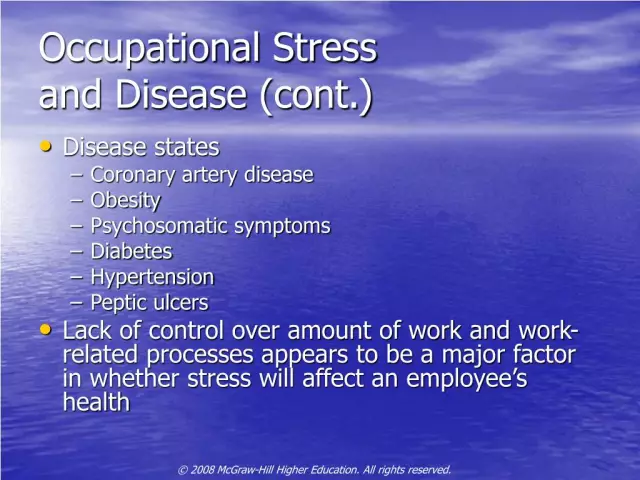- Author Rachel Wainwright [email protected].
- Public 2023-12-15 07:39.
- Last modified 2025-11-02 20:14.
Occupational stress

Based on the medical definition of stress, a violation of professional adaptation is regarded as a neurotic syndrome. That is, neurosis. It is a psychosomatic disorder described by the German psychiatrist Jaspers in 1913. All kinds of occupational stress have signs of the Jaspers triad:
- The reason is mental trauma;
- Mental disorders reflect the psychogenic and traumatic situation and do not go beyond it;
- All health problems stop immediately after the cause is eliminated.
In advanced cases, eliminating the cause is impossible, because occupational stress progresses to mental illness.
A person's susceptibility to mental trauma occurs only when there is an imbalance between capabilities and abilities. In other words, in conditions of overestimation of one's own strengths.
Types of occupational stress
Overstrain of the nervous system during the performance of work duties is manifested by emotional outbursts that provoke extreme situations. Over time, the threshold of extremity decreases, and it is not difficult to piss off an employee who is in constant overstrain. Sometimes a loud sound or a bright light from an unexpectedly turned on lamp is enough for this.
Psychologists distinguish the following types of occupational stress in enterprise workers:
- Informational. It arises in conditions of time pressure, when it becomes impossible to cope with assigned tasks in a short period of time, in view of the increased responsibility for the decisions made. The intensity of higher nervous activity increases with frequently changing requirements. Sometimes information parameters are introduced at the final stage of work, which requires a radical rework;
- Emotional. It implies protracted conflict situations in the work collective, especially with management. The threat of dismissal does not contribute to the normal psychological state.
- Communicative. A kind of emotional professional stress, limited by communication problems, both with colleagues and with those people with whom a person contacts on duty.
The varieties of the adaptation syndrome in the sphere of industrial relations largely depend on the nature of the personality, but they proceed in the same pattern for everyone.
The mechanism of development of professional stress
Adaptive syndrome at the level of human higher nervous activity undergoes three stages of development:
- Launch. Tension accumulates to the limit, after which the reverse development is impossible. For some people, the first stage lasts for many days or even months, for others, for a few minutes;
- The heat of passion. A person loses the ability to self-control and does exactly the opposite. Calm people become aggressive, outgoing people become gloomy and withdrawn.
- Prostration. Internal tension subsides, and the person becomes himself. He feels guilty and remorseful.
Even a single nervous breakdown does not go unnoticed. At the level of the higher nervous system, a pathological stereotype is fixed. This is how professional stress becomes routine. It is not only and not so much the nervous reaction that suffers - the internal organs are affected. The constant centralization of blood circulation leads to oxygen starvation of peripheral organs, peptic ulcer disease worsens, varicose veins develop, and potency decreases.
Occupational stress factors
There are groups of factors that contribute to the development of situational neuroses associated with professional activity:
- Labor. Underloading or overloading work. If a person at work does not have enough workload, the employee begins to consider himself underestimated and to some extent inferior. With increased workload, the employee is in a state of alarm;
- Official. Incomprehensible requirements for the performance of work create a sense of uncertainty. Employees do not know and cannot imagine how the results of their work will be evaluated by their superiors;
- Career. These occupational stressors have two components: fear of dismissal and delayed professional advancement;
- Personal. The problem of allocating time for family and work.
In addition to psychological reasons, there are physical stress factors: unsettled workplace, noise, vibration, contact with hazardous substances.
Occupational stress test
More often than not, employees take the current situation at work for granted and do not try to change anything. Someone constantly does not cope with work, but successfully creates the appearance of stormy activity. Someone works for three and is not marked by the authorities. Oddly enough, both workers are susceptible to the development of professional stress. Some lack work, others - recognition of imaginary or real merit.
To exclude difficult psychological situations at work, psychologists have developed a special test for occupational stress, the assessment of which allows one to draw the necessary conclusions. When tensions are identified in the team, the management needs to change something. And as soon as possible. An explosive atmosphere in the team will lead to complete paralysis of work. Not long to lose valuable employees who, if they do not quit, will lose their ability to work for a long time. In connection with myocardial infarction, for example. And the cause of cardiac pathology will be a neurotic disorder of the psyche.
Prevention of occupational stress
Based on the signs of neuroses according to Jaspers, including professional ones, the liberation of a person from a nervous disorder suggests itself. If reactive mental disorders disappear after removing the cause, you should get rid of it. However, layoffs do not solve the problem. Therefore, the leader should take more effective measures to improve the psychological microclimate in the team. Occupational stress prevention involves the following leadership steps:
- Correct assessment of the abilities of subordinates, taking into account their inclinations and needs;
- Drawing up a clear action plan with specific areas of authority;
-

Occupational stress - causes, symptoms, help Change of leadership style from dictatorial to mentoring, when the boss discusses complex tasks with employees, suggests ways to solve them;
- Using the incentive of material interest.
To overcome occupational stress, employees are encouraged to use the following self-regulation methods:
- Setting short-term tasks, the solution of which increases self-esteem and provides long-term motivation;
- Correct organization of work and rest;
- Refusal from unnecessary competition that requires a full commitment of forces;
- Timely switching from one type of activity to another within the profession.
Every person, regardless of their position, needs to remember that work is only a part of his life.
Found a mistake in the text? Select it and press Ctrl + Enter.






